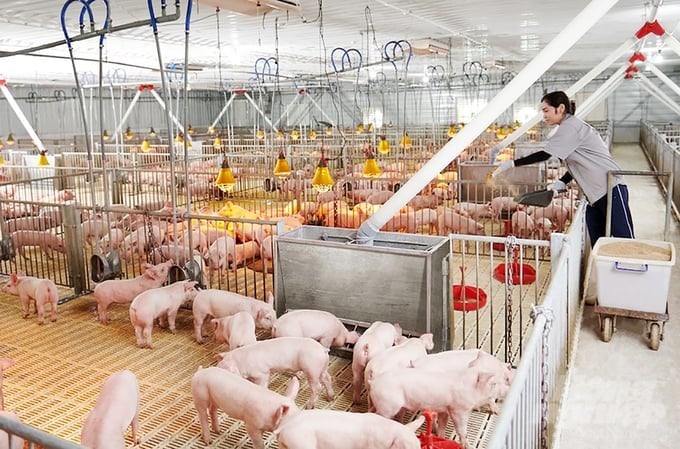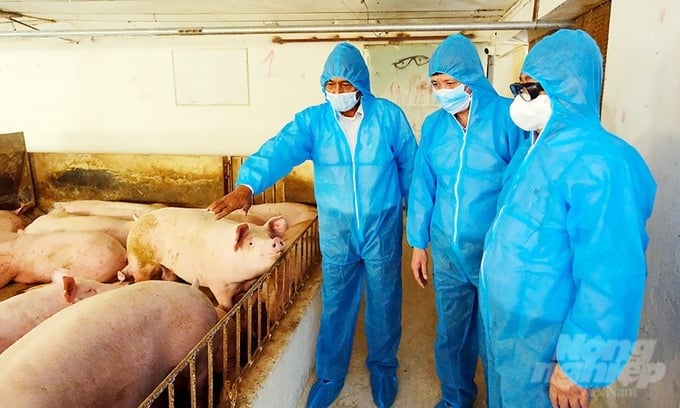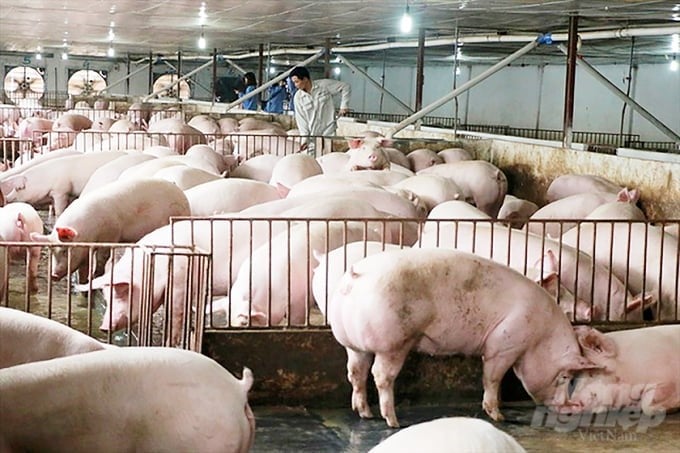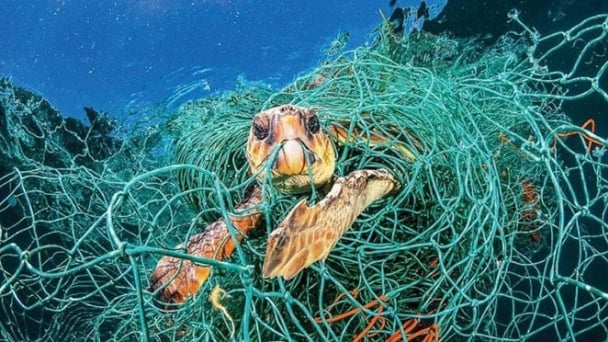June 15, 2025 | 09:42 GMT +7
June 15, 2025 | 09:42 GMT +7
Hotline: 0913.378.918
June 15, 2025 | 09:42 GMT +7
Hotline: 0913.378.918

The trend of restructuring the pig farming industry towards modernization and industrialization Photo: MS.
According to the Department of Livestock Production, over the past five years, the rate of smallholding livestock farming has decreased by 5-7%/year. In the period 2019–2022 alone, small farming facilities in the scale of farmer households have decreased by 15-20%. Currently, the output of pigs produced by small farmer households has reduced to 35–40%, while the output of pigs produced by professional households and farms accounts for 60–65%. This is the trend of restructuring the pig farming industry towards modernization and industrialization.
As of October 2023, live-weight pork output is estimated to reach over 3.63 million tons, an increase of 6.8% over the same period in 2022. However, the livestock industry is still facing many limitations and difficulties. Especially in the 10 months of 2023, the price of livestock products fluctuated greatly, causing the total pig herd to change. In particular, since the African swine fever epidemic broke out, the total pig herd has decreased, but the price has not fluctuated much.
Mr. Pham Kim Dang, Deputy Director of the Department of Livestock Production, said that Vietnam has many advantages in livestock development and is currently ranked the first among the 10 largest pork-consuming countries in the region. In particular, Vietnam has a quite diverse distribution system, reaching even remote areas in need. However, this can also be considered a disadvantage because the small scale of livestock farming still accounts for a large proportion, along with the asynchronous slaughter system, making it difficult to control epidemics.
According to experts, domestic production capacity is meeting about 95% of the needs of the domestic market with 100 million people, and the rest is imported. The livestock industry is also continuing to develop decrees and plans to improve livestock efficiency, which will be submitted to the Government for approval in December 2023. Realizing that Vietnam is a large market with 100 million people and has the potential for livestock farming, many corporations and businesses from other countries are investing in Vietnam. Even domestic businesses are also transforming to invest in cattle and poultry farming.
As of October 2023, the total pig herd is gradually recovering and has reached about 30 million heads. This is a positive result after the pig farming industry has been heavily affected by African swine fever since 2019. The supply structure has also been improved by businesses and large farms with methodical investments.

Since the African swine fever epidemic broke out, the total pig herd has decreased, but the food price has not fluctuated much. Photo: MS.
Although the pig farming industry has seen a high increase in output, it is facing difficulties because the price of live-weight pork is at a low level while animal feed costs always skyrocket. This is a big challenge for farmers and businesses in the industry.
According to Mr. Nguyen Kim Doan, Vice Chairman of the Dong Nai Livestock Association, since the beginning of 2023, in the livestock "capital" of Dong Nai, the epidemic situation has been threatening most livestock farms and farmer households. Therefore, farmers are forced to sell pigs early at cheap prices to "release" the herd and avoid heavy losses. "Vaccines are exactly a "float" to help farmers protect their pig herds. This is also farmers’ hope of avoiding capital losses when investing in livestock farming and possibly continuing repopulation in the coming time," he said.

Vaccines are still considered the "steel shield" that saves the livestock herd during disease outbreaks. Photo: MV.
Dong Thap is also a locality focusing on disease prevention and control in all livestock herds. Currently, pig farmers are facing many difficulties due to highly increasing feed prices, leading to higher cost prices than selling prices.
Mr. Vo Be Hien, Director of the Dong Thap Sub-Department of Animal Husbandry, Veterinary Medicine, and Fisheries, confirmed: "The current livestock situation is changing. Due to complicated epidemics and lower selling prices than cost prices, farmers encounter many difficulties, not daring to invest in expanding scale because the more they invest, the more they lose. Therefore, depending on the market, farmers will decide to invest in repopulation and develop more."
In fact, the domestic livestock industry also realizes that the issue of applying biosafety and disease safety to livestock farming has not been implemented synchronously. At the same time, food and pork prices on the market do not change much, affecting the economy and sustainable livestock development.
According to the Department of Livestock Production, depending heavily on input materials, especially the continuously high increase in the price of animal feed raw materials, is also a challenge for the livestock industry. Particularly when the epidemic broke out, production costs increased due to having to control many stages, causing production costs and the competitiveness of Vietnam's livestock products to be increasingly affected. Not to mention that when Vietnam implements global agreements and commitments and must compete with countries around the world, this is also a big challenge.
"By the end of October 2023, the pig herd grew by 3.4%, the poultry herd by 2.9%, and the meat cow herd by 0.9%. Livestock farming still has a growth rate of 5.93%, which is equal to or slightly lower than in 2022. During the Lunar New Year, food demand will also increase by 15–20%. To be proactive in supply, first of all, the livestock industry and localities need to have many solutions to prevent and control epidemics. The solution may be medicine, biosecurity, or disease safety, but vaccines are still the "steel shield" to save the cattle and poultry herds," Deputy Minister Phung Duc Tien emphasized.
Translated by Huyen Vu Thu

(VAN) The working delegation from the Ministry of Agriculture and Environment conducted an important trip to the Netherlands to strengthen strategic partnerships and sustainable development in the agricultural sector.

(VAN) The letter ‘A Plea from the Ocean’ not only evokes emotion but also awakens the human conscience to the responsibility of protecting life on Earth.

(VAN) The Department of Agriculture in South Africa has announced the country’s first mass vaccination of poultry to prevent local birds from contracting avian influenza.

(VAN) Establishment of the Mekong Delta Regional Agricultural Linkage Center, aiming for a closed value chain, deep processing, trading platforms, and international market connectivity.

(VAN) Gia Lai province has recently recorded 460 rare species of animals and plants, contributing to forest conservation and biodiversity planning in the region.

(VAN) Ms. Caroline Beresford, New Zealand Ambassador to Vietnam, expressed confidence that agricultural cooperation between Vietnam and New Zealand will develop sustainably, be climate-resilient, and promote gender equality.

(VAN) Vietnam reaffirms its commitment to international cooperation in fostering sustainable and responsible fisheries while ensuring resilient livelihoods for small-scale fishing communities.